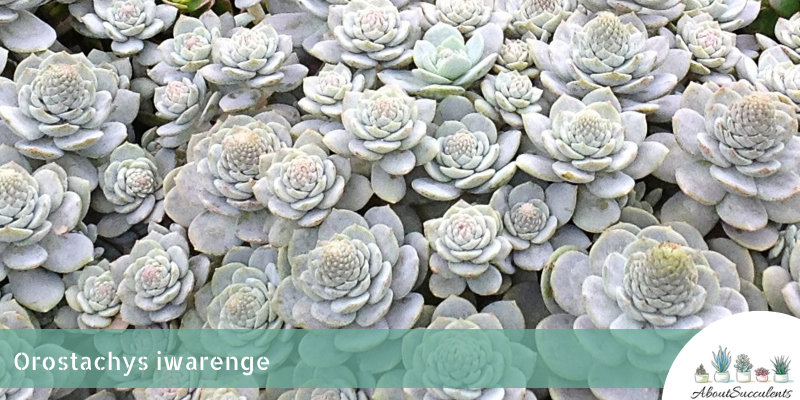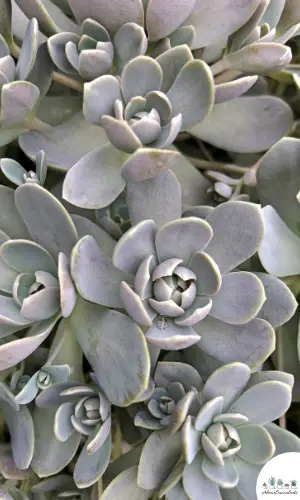
Orostachys iwarenge is a charming perennial succulent that is characterized by its long stems that sit atop cone-shaped and lavender-colored rosettes. In fact, its name is a description of the rosettes and their position on the stems. A fully-grown succulent can reach a height of 6-inches (15cm).
Speaking of names, Orostachys iwarenge goes by the common names “Chinese Dunce Cap” and “Dunce Cap” alluding to the cone-shaped of the rosettes.
Also, the common names refer to Northern China, where it originated from. It has also been discovered that Chinese Dunce Cap might have also come from Japan and Mongolia. These regions have one thing in common – mountainous terrain with frigid weather conditions.
Another possibility for having the word “Dunce” in its nickname is that Orostachys iwarenge might trick you into thinking it’s dead during winter. But wait until spring rolls in and Chinese Dunce Cap will spring back to life.
However, Orostachys iwarenge is a monocarpic succulent and actually dies after it blooms. Dunce Cap’s blooming period is in late summer when you’ll see white and yellow-colored flowers grow out from the center of the mother rosette.
Plant hobbyists love Chinese Dunce Cap because it produces several offsets on the stems that arise from the main rosette. These offsets are used for easy propagation of the species.
Orostachys iwarenge comes from the genus Orostachys and is a member of the Crassulaceae family.
General Information
Also known as: Chinese Dunce Cap, Dunce Cap
Plant Family: Crassulaceae
Origin: Northern China and parts of Japan and Mongolia.
Height: 6-inches (15cm)
Exposure: Partial or full sun for up to 6 hours; avoid the afternoon sun.
Water Needs: Drought-tolerant; use the “Soak and Dry” method for watering
Soil Type: Well-draining soil such as cactus or 2 parts potting soil mixed with 1 part perlite, pumice, coarse sand, or lava rock.
Soil pH: 7.9 to 8.5
How to Grow and Care for Orostachys Iwarenge
Do you live in a region that gets chilly? If so, Orostachys iwarenge will be the perfect addition to your outdoor garden.
Chinese Dunce Cap is more tolerant of frosty conditions than most succulent plants. However, If the temperature in your area drops lower than -10° F (-23.3° C), it would be a good idea to plant this succulent in a container that you can move indoors.
If you follow our care tips below, you won’t have problems growing Orostachys iwarenge in your outdoor garden or inside your home.
Sunlight

It’s very important for Orostachys iwarenge to get the sun’s rays on a daily basis. Without enough sunlight, its leaves will stretch out, wither, and get weak because of a process called etiolation.
As an outdoor garden succulent, plant Dunce Cap in an area that regularly receives 6 hours of partial to full sunlight. Never expose Orostachys iwarenge to the afternoon sun as its rays get extremely hot and will burn the succulent plant’s leaves. The morning sun is always the best choice for these types of plants.
If you decide to have Chinese Dunce Cap as an indoor plant, place it near a window that gets 4 to 6 hours of partial sunlight per day. You can also place Dunce Cap under a Grow Light.
Watering
If Orostachys iwarenge needs its daily dose of the sun’s rays every day, the same can’t be said about its need for water.
Succulents aren’t like most types of plants. These are considered cacti because succulents can store water in their leaves and stems to keep them alive during drought.
Treating Chinese Dunce Cap like an ordinary plant and watering it frequently will do more harm than good. In fact, overwatering will kill it.
When it comes to watering, less is best. Follow the “Soak and Dry” method for best results.
First, check the soil’s dryness by inserting a stick an inch deep. Pull out the stick and if it feels dry, then give the soil a thorough soaking. Yes, water the soil. Don’t water the plant directly.
You might find yourself watering Dunce Cap every seven to 10 days during the growing months of spring and summer. In contrast, winter causes the soil to retain moisture longer. You might water the soil only once per month during the cold season.
Pot and Soil
The best pot for Orostachys iwarenge is one that allows moisture to escape from the soil right away. This means choosing only between 2 types of materials – unglazed ceramic or terracotta.
Both of these pots are highly absorbent and enable moisture to evaporate from the soil. Take note “unglazed” ceramic pot. Unglazed pots are made of organic materials and don’t include contaminants that affect their absorbent properties.
Always choose a pot that’s slightly bigger than the base of your plant because it will continue to grow. As the succulent grows, so will its roots. You want the roots to have enough space in the soil without getting entangled.
Lastly, check that the bottom of the pot has a drainage hole to filter out excess water from the soil.
Chinese Dunce Cap prefers well-draining soil. You can plant Dunce Cap in cacti soil or use potting soil with added gritty materials to improve drainage.
The best gritty materials are perlite, pumice, coarse sand, and lava rocks. Combine 2 parts of potting soil with 1 part of gritty materials for the best results.
Adding fertilizer to the soil is a good idea to improve the quality of nutrients. This is especially important if Chinese Dunce Cap is a houseplant.
Choose a brand of organic fertilizer with low nitrogen content and dilute it to only 25% of its original strength. Fertilize only twice during the growing season or once a month during the first 2 months.
How to Propagate Orostachys Iwarenge
Orostachys iwarenge can be propagated by using the offsets growing on its stems. It’s important to choose only offsets that are mature or big enough to have their own root system.
You can also propagate Chinese Dunce Cap via seeds. Once the succulent has produced its flowers you can collect the seeds and use them to grow new plants.
Offsets Method
Step 1: Use a sterilized knife to gently remove the offsets from the stem. Make sure the roots stay intact.
Step 2: Allow the offsets to dry out and grow hard calluses over a period of 2 to 4 days.
Step 3: Plant the calloused offsets in well-draining soil.
Step 4: Lightly spray the soil with water to keep it moist. Place the pot near a window that gets partial sun for 6 hours every day.
Step 5: Once the roots have firmly taken hold in the soil, back off the watering schedule and use the soak and dry method.
Seeds Method
Step 1: Plant the seeds in well-draining soil.
Step 2: Lightly water the soil and place the pot under a Grow Light. You can also use a Seed Mat.
Step 3: When the roots have fully formed, water the soil only when it has dried out completely.
Frequently Asked Questions
Is Orostachys Iwarenge Toxic to Cats and Dogs?
Orostachys Iwarenge isn’t included in the list of plants that are toxic to cats and dogs found on the website of the American Society for the Prevention of Cruelty to Animals (ASPCA).
Why Is My Orostachys Iwarenge Dying?
Orostachys iwarenge is a durable plant that’s resilient to both drought and frost but it can be fallen by overwatering and pest infestation.
Overwatering
Do the leaves look mushy to you? Do you notice any yellow spots that seem a bit brownish or blackish appearing on the leaves?
Similar to personal health, early prevention is the best way to cure an illness – and Chinese Dunce Cap might have developed a fungal infection because the roots have rotted from overwatering.
Get a sharp knife and sterilize the blade with 70% isopropyl alcohol. Cut off the infected sections of the plant to prevent the infection from spreading further. Once this is done, sanitize the knife once again and do the same to the roots – cut off the ones that have rotted away.
Orostachys iwarenge needs a new pot. While the succulent is resting and drying out, fill a new pot with fresh succulent soil. Repot Dunce Cap but put off watering for 2 to 3 days more.
Pest Infestation
Mealybugs, aphids, and scale insects are pests that are so small you can’t see them on the leaves. But make no mistake about it – they’re there and they can do big damage to Orostachys iwarenge.
If you see whitish, waxy substances on the leaves, wipe them off with a cotton ball soaked in 70% isopropyl alcohol. These substances can contaminate the plant.
Then, spray Dunce Cap with a natural pesticide such as neem oil to keep these pests. Mealybugs and aphids enjoy eating the leaves and drinking the sap of succulent plants.
Yes. Orostachys Iwarenge produces small, white and yellow-colored flowers in the summer. As a monocarpic succulent, Chinese Dunce Cap will die after blooming.
Last Updated on June 14, 2022 by Sofia Lara